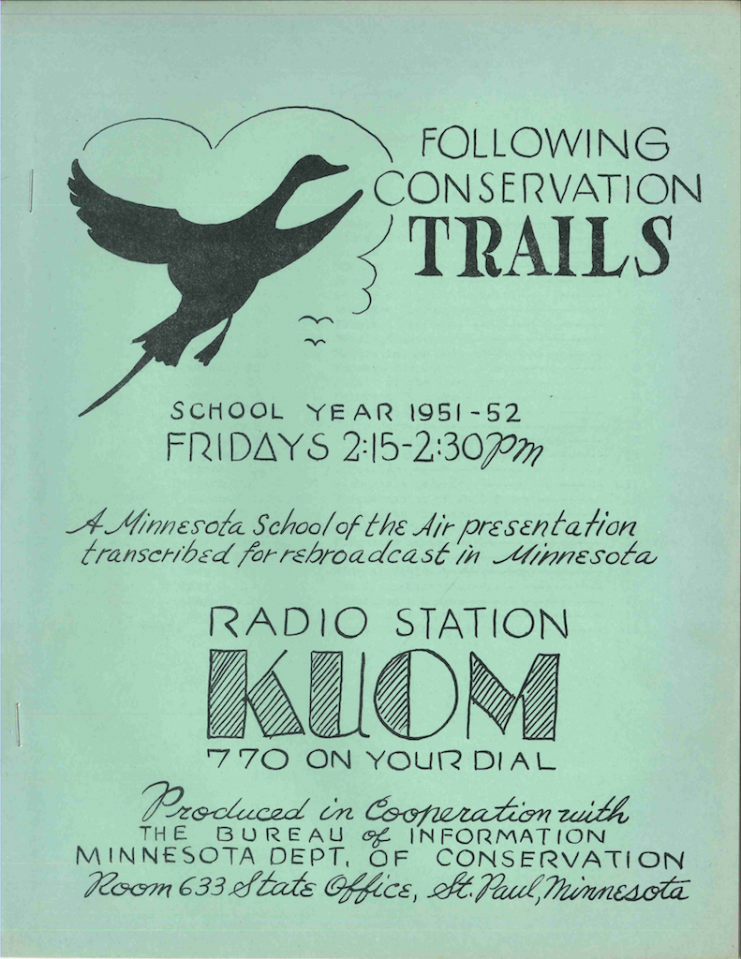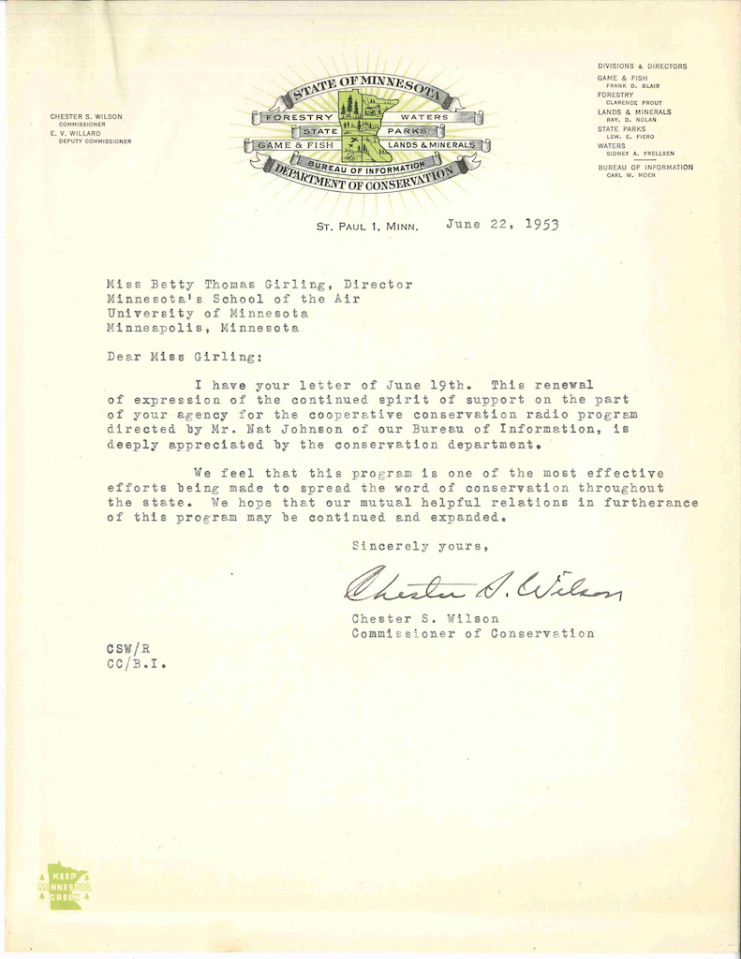Welcome back to U of M Radio on Your Historic Dial!
It’s starting to feel like spring, or what this Minnesota transplant refers to as “outside time.” With so much natural recreation to offer, it’s no surprise that Minnesota has a strong culture of conservation that goes back decades. Earth Day isn’t until April 22, but on this week’s program, Down the Conservation Trail, we’re getting a head start.
You can listen to the episode here in the browser and read the script below.
Podcast (umnradio): Play in new window | Download
Episode 08: Down the Conservation Trail
You are listening to U of M Radio on Your Historic Dial podcast and this is episode 8: Down the Conservation Trail.
Hello! This is Hannah, from University Archives. Today’s featured program will take us into Minnesota’s famous outdoors, from Sandy Lake to the Boundary Waters. We’ll be listening to one of the Minnesota School of the Air’s longest running programs, Following Conservation Trails.
Following Conservation Trails ran from 1947 to 1968 and addressed issues related to conservation, the environment, and natural resources. The episodes presented classroom friendly material through a set formula, consisting of an overview of the topic, a dramatization, and a discussion of what preservation efforts could be made in and out of school. The radio-plays often featured a similar cast of characters: a younger girl and boy, an older family member, and Nat Hammond, naturalist and wilderness guide extraordinaire. The topics focused on in the episodes included wildlife management, forest and grass fires, watersheds, soil erosion, habitats, and other ecologically-minded lessons. Other notable episodes highlighted Minnesota’s major parks, such as Itasca State Park, Voyageurs National Park, and Fort Snelling State Park. There was also an emphasis on the role humanity has as the stewards of the natural world, and the importance of conservation for future generations.
Episodes were 12 to 15 minutes in length and taught quick lessons that would supplement a school’s science curriculum. Every year, a teacher’s manual was produced to reinforce the educational information and provide activities and discussion around the topics. This first clip comes from the 1967 episode, A Living Chain, in which the younger character gives a clear, textbook definition of ecology, and the guide character explains animal behavioral patterns, how they evolved over time, and how they fit into the natural order. You can imagine teachers telling their students that, “yes, this will be on the test.”
The next clip is from a 1962 episode called Down to the Sea, which taught listeners about soil erosion caused by water run-off. Recurring characters Martha and Gramps receive a letter from their ranger friend Nat Hammond about the success the Muskegon Valley has had with controlling erosion and runoff, and Gramps comments that it’s about time everyone starts addressing the problem of water supply. Later, the two relax near a river with Martha’s brother Jim, who recounts what he’s learned about the disappearance of valuable top soil due to excessive water runoff.
More than one episode was dedicated to the natural wonders found along the Gunflint Trail up to the Quetico-Superior wilderness, also referred to as the Boundary Waters, and the history of the fur-trading Voyageurs. These episodes seem designed to inspire strong feelings over the preservation of these historically and ecologically relevant areas, and the importance of keeping them unpolluted for future generations. In this clip, Martha, Jim, and Gramps, along with the ever-present Nat Hammond go on a camping trip in “Minnesota Canoe Country.” While Gramps rhapsodizes about the uniqueness of the area with its proximity to urban centers and the Canadian border, the children state that they hope the wilderness area will be able to stay the same and be enjoyed by children in the future.
The majority of the programs were produced and presented by Nat Johnson, educational advisor for the Minnesota State Department of Conservation.
Johnson was a constant presence on the show. He often narrated the programs and he wrote most of the scripts. In a letter, Betty T. Girling, the Director of the Minnesota School of the Air refers to him fondly as “Mr. Conservation,” writing, “In 1947 when we started, never did I think it would be such a wondrous trail…When I think of all the people who have worked on that series…if you’d just converted them to conservation, you’d have done a mighty task. But all those other thousands, some now grown-up and teaching their own children the ideas gleaned from you over so many years of broadcasting…”
Of the multitude of children who listened to Following Conservation Trails during its 20-year run, it is easy to imagine one, or many, of them continuing Johnson’s work today.
That’s all for today. Tune in later this month for another science-themed episode, as we listen in on Science Lives, one of the later programs produced by KUOM. Thanks for listening!
The U of M Radio on Your Historic Dial podcast is produced every other week for your enjoyment. Subscribe or download on iTunes or GooglePlay so you don’t miss another moment of historic Minnesota radio.
If you enjoy our clips and want to hear or learn more, go to www.lib.umn.edu/uarchives, and search KUOM in the collection guides.
Digitization of University Archives recordings was financed in part with funds provided by the State of Minnesota from the Arts and Cultural Heritage Fund through the Minnesota Historical Society.
—Hannah O’Neill is a project archivist for the University of Minnesota Archives. To learn more about the University of Minnesota Archives, please visit www.lib.umn.edu/uarchives.






